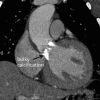Transcatheter aortic valve replacement with balloon-expandable valve : Analysis of initial experience in China
- PMID: 29236149
- PMCID: PMC6280821
- DOI: 10.1007/s00059-017-4622-x
Transcatheter aortic valve replacement with balloon-expandable valve : Analysis of initial experience in China
Abstract
Background: Transcatheter aortic valve replacement (TAVR) is widely applied for the treatment of severe aortic stenosis (AS) in developed countries; however, in China, it is still in the early stage of utilization. On the basis of previous studies, this work explored the feasibility of TAVR in patients with severe AS in China and analyzed the cause of death in four cases.
Methods: This retrospective study included 20 patients who had severe AS and underwent TAVR with a balloon-expandable system (Edwards SAPIEN XT) in our hospital from January 2011 to June 2016. The valve and heart functions of 16 survivors before and after the TAVR procedure were compared. TAVR endpoints, device success, and adverse events were assessed according to the definitions of the Valve Academic Research Consortium-2 (VARC-2).
Results: There were 13 male and seven female patients aged 65-81 years (average, 73.15) who underwent TAVR. The TAVR approach was transfemoral in 19 patients and transapical in one patient. Four patients died (two of coronary artery occlusion and two of aortic annulus rupture) during the TAVR procedure or shortly after; six patients had mild paravalvular leakage, and the rest of the patients showed a significant improvement in cardiac function. During the follow-up period (2-62 months), one patient died of lung cancer 13 months after the TAVR procedure.
Conclusion: TAVR with a balloon-expandable system is safe and effective and can be used for patients with severe AS in China. It requires careful patient selection and preoperative assessment so as to reduce the 30-day postoperative mortality rate.
Hintergrund: Der Transkatheter-Aortenklappenersatz („transcatheter aortic valve replacement“, TAVR) ist in Industrieländern zur Behandlung der schweren Aortenstenose (AS) weit verbreitet, in China jedoch ist er immer noch im Frühstadium der Anwendung. Auf der Grundlage vorhergehender Studien wurde in der vorliegenden Arbeit die Durchführbarkeit der TAVR-Operation bei Patienten mit schwerer AS in China untersucht und in 4 Fällen die Todesursache analysiert.
Methoden: In die retrospektive Studie wurden 20 Patienten aufgenommen, bei denen eine schwere AS vorlag und eine TAVR-Operation mit einem ballondilatierbaren System (SAPIEN XT, Fa. Edwards, Irvine/CA, USA) zwischen Januar 2011 und Juni 2016 in der Klinik der Autoren erfolgte. Klappen- und Herzfunktion der 16 überlebenden Patienten wurden vor und nach der TAVR-Operation verglichen. TAVR-Endpunkte, erfolgreicher Geräteeinsatz und Nebenwirkungen wurden gemäß den Definitionen des Valve Academic Research Consortium-2 (VARC-2) ermittelt.
Ergebnisse: Bei 13 männlichen und 7 weiblichen Patienten im Alter von 65 bis 81 Jahren (Durchschnitt: 73,15) wurde eine TAVR-Operation durchgeführt. Der Zugang für den TAVR war bei 19 Patienten transfemoral und bei einem Patienten transapikal. Es starben 4 Patienten (2 durch Koronararterienverschluss und 2 durch eine Ruptur des Aortenrings) während der TAVR-Operation oder kurz danach; 6 Patienten wiesen eine leichtgradige paravalvuläre Leckage auf, und bei den übrigen Patienten zeigte sich eine deutliche Verbesserung der Herzfunktion. Während der Nachbeobachtungsphase (2–62 Monate) starb ein Patient 13 Monate nach der TAVR-Operation an einem Bronchialkarzinom.
Schlussfolgerung: Die TAVR-Operation mit einem ballondilatierbaren System ist sicher und wirksam und kann bei Patienten mit schwerer AS in China eingesetzt werden. Es bedarf einer sorgfältigen Patientenauswahl und präoperativen Untersuchung, um die postoperative 30-Tage-Mortalitätsrate zu senken.
Keywords: Aortic valve stenosis; China; Coronary angiography; Minimally invasive surgery; Patient selection.
Conflict of interest statement
Y. Shen, H. Zhang, L. Zhang, H. Li, H. Mao, Y. Pei, Z. Jing, and Q. Lu declare that they have no competing interests.
Figures




References
-
- Osnabrugge RL, Mylotte D, Head SJ, Van Mieghem NM, Nkomo VT, LeReun CM, Bogers AJ, Piazza N, Kappetein AP. Aortic stenosis in the elderly:disease prevalence and number of candidates for transcatheter aortic valve replacement:a meta-analysis and modeling study. J Am Coll Cardiol. 2013;62(11):1002–1012. doi: 10.1016/j.jacc.2013.05.015. - DOI - PubMed
-
- Cribier A, Eltchaninoff H, Tron C, Bauer F, Agatiello C, Sebagh L, Bash A, Nusimovici D, Litzler PY, Bessou JP, Leon MB. Early experience with percutaneous transcatheter implantation of heart valve prosthesis for the treatment of end-stage inoperable patients with calcific aortic stenosis. J Am Coll Cardiol. 2004;43(4):698–703. doi: 10.1016/j.jacc.2003.11.026. - DOI - PubMed
-
- Reardon MJ, Adams DH, Kleiman NS, Yakubov SJ, Coselli JS, Deeb GM, Gleason TG, Lee JS, Hermiller JB, Jr, Chetcuti S, Heiser J, Merhi W, Zorn GL, 3rd, Tadros P, Robinson N, Petrossian G, Hughes GC, Harrison JK, Maini B, Mumtaz M, Conte JV, Resar JR, Aharonian V, Pfeffer T, Oh JK, Qiao H, Popma JJ. 2-year outcomes in patients undergoing surgical or self-expanding transcatheter aortic valve replacement. J Am Coll Cardiol. 2015;66(2):113–121. doi: 10.1016/j.jacc.2015.05.017. - DOI - PubMed
-
- Mohr FW, Holzhey D, Möllmann H, Beckmann A, Veit C, Figulla HR, Cremer J, Kuck KH, Lange R, Zahn R, Sack S, Schuler G, Walther T, Beyersdorf F, Böhm M, Heusch G, Funkat AK, Meinertz T, Neumann T, Papoutsis K, Schneider S, Welz A, Hamm CW. The German Aortic Valve Registry: 1‑year results from 13, 680 patients with aortic valve disease. Eur J Cardiothorac Surg. 2014;46(5):808–816. doi: 10.1093/ejcts/ezu290. - DOI - PubMed
MeSH terms
Grants and funding
LinkOut - more resources
Full Text Sources
Other Literature Sources
Research Materials

